

An encyclopedia of Middle-earth and Numenor

|
|
|
|
|
|
|
|
|
|
|
|
|
|
| |
|
 |

An encyclopedia of Middle-earth and Numenor |
 |

See also: Dwellings,
Public
Buildings, Fortresses & Towers
|
|
|
|
|
|
|
|
|
|
The Brandywine Bridge was located on the eastern border of the Shire. Distances across the Shire were measured starting from the eastern end of the Brandywine Bridge. Just east of the Bridge on the south side of the Great East Road, the North-gate through the High Hay led into Buckland. The Road then continued past the Old Forest and on to Bree about 40 miles away.
The region of Bridgefields in the Shire was immediately west of the Brandywine Bridge. The Bridge Inn was a resting place for travellers on the west side of the Bridge. The Causeway ran south from the Brandywine Bridge to Stock and on through the Marish to Rushey and Deephallow.
The Brandywine Bridge was built by the Men of Arnor in the early days of the North-kingdom, which was founded in 3320 of the Second Age. It was part of the Great East Road which was the major thoroughfare across Eriador.
In 1601 of the Third Age, King Argeleb II gave permission to a group of Hobbits led by Marcho and Blanco to settle the land west of the Brandywine Bridge as far as the Far Downs. In exchange, the Hobbits of the Shire were required to keep the roads and bridges, including the Brandywine Bridge, in good repair.
During the War of the Ring, the Shire was occupied by Men in the service of Saruman. They erected great spiked gates at either end of the Brandywine Bridge. The gates were locked between sundown and sunrise and no one was permitted across. They tore down the Bridge Inn and replaced it with guard-houses. Hob Hayward was one of the guards stationed at the Bridge, and a Man of Bree named Bill Ferny supervised the Hobbit guards.
Frodo, Sam, Merry and Pippin returned to the Shire on the night of October 30, 3019, and found the gates on the Bridge locked. Merry and Pippin climbed the east gate and forced Bill Ferny to unlock it. The Hobbit guards let them through the west gate and they spent the night in a guard-house. The Men were driven from the Shire in the Battle of Bywater on November 3. Afterwards, everything the Men had built in the Shire was dismantled, presumably including the guard-houses and the gates on the Bridge.
In the year 15 of the Fourth Age, Aragorn, King Elessar, met with Sam, Merry and Pippin at the Brandywine Bridge. The King had decreed that Men were not allowed to enter the Shire, but he came to the Brandywine Bridge from time to time so that Hobbits could see and speak with him.
Names &
Etymology:
The proper name of the Brandywine
Bridge was the Bridge of Stonebows. It was so named because
of the three stone arches supporting it. It was also called the Great
Bridge.
Sources:
The Fellowship
of the Ring: "Prologue - Concerning Hobbits," p. 13-14; "A Long-Expected
Party," p. 33; "Three Is Company," p. 77, 80; "A Short Cut to Mushrooms,"
p. 97; "A Conspiracy Unmasked," p. 109-10, 117; "At the Sign of the Prancing
Pony," p. 162
The Return
of the King: "Homeward Bound," p. 275-76; "The Scouring of the Shire,"
p. 277-80; "The Grey Havens," p. 302
Appendix
A of The Lord of the Rings: "The North-kingdom and the Dunedain," p.
324
Appendix
B of The Lord of the Rings: "The Tale of Years," p. 378
The Lord
of the Rings: A Reader's Companion by Wayne G. Hammond and Christina
Scull: "Prologue," p. 20
Bridge of Khazad-dûm |
The
Bridge of Khazad-dum
Artwork from the New Line film |
 Bridge
between the First Hall and Second Hall of Khazad-dum.
The Bridge of Khazad-dum spanned an abyss of unmeasured depth. On the west
side of the Bridge was the Second Hall. On the east side was a doorway
and a broad staircase. The stairs led up to a wide passage to the First
Hall, beyond which was the East-gate.
Bridge
between the First Hall and Second Hall of Khazad-dum.
The Bridge of Khazad-dum spanned an abyss of unmeasured depth. On the west
side of the Bridge was the Second Hall. On the east side was a doorway
and a broad staircase. The stairs led up to a wide passage to the First
Hall, beyond which was the East-gate.
The Bridge was a 50-foot long stone curve with no railing. It was narrow so that people had to walk single-file across it as a preventative measure against invaders.
On January 15, 3019 of the Third Age, the Fellowship came to the Bridge of Khazad-dum pursued by Orcs and a Balrog. Gandalf stopped on the Bridge to confront the Balrog in order to allow the others to escape. He broke the Bridge with his staff and the Balrog fell into the abyss, but the Balrog snared Gandalf with its whip and they both plummeted together into the depths of the earth.
Names &
Etymology:
Also called Durin's Bridge.
Sources:
The Fellowship
of the Ring: "The Bridge of Khazad-dum," p. 336, 342-46; "The Mirror
of Galadriel," p. 371, 375
The Two
Towers: "The White Rider," p. 105
Iant Iaur |
Map
showing Iant Iaur
|
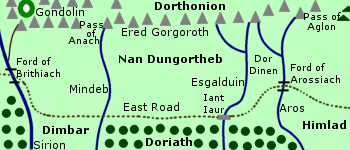 Bridge
over the Esgalduin. Iant Iaur was located
on the northern border of the woodland realm of Doriath.
The East Road passed over the old stone bridge on its way through Nan Dungortheb,
the valley between Doriath and the Ered Gorgoroth. The Esgalduin could
not be crossed at any other point in the valley.
Bridge
over the Esgalduin. Iant Iaur was located
on the northern border of the woodland realm of Doriath.
The East Road passed over the old stone bridge on its way through Nan Dungortheb,
the valley between Doriath and the Ered Gorgoroth. The Esgalduin could
not be crossed at any other point in the valley.
Iant Iaur was built during the Years of the Trees before Morgoth returned to Middle-earth. In the First Age, Nan Dungortheb became a place of evil inhabited by the offspring of Ungoliant.
The march-wardens of Doriath kept watch on Iant Iaur, but the East Road was dangerous. Some intrepid travellers nevertheless continued to use it. Aredhel crossed the bridge on her way from Gondolin to Himlad in 316 of the First Age.
Names &
Etymology:
The name Iant Iaur means
"Old Bridge" in Sindarin from iant meaning "bridge" and iaur
meaning "old." An alternate name was Esgaliant from iant,
"bridge," combined with the river name Esgalduin meaning "River
under Veil" where esgal means "screen, hiding, roof of leaves."
Also called the Bridge of Esgalduin.
Sources:
The Silmarillion:
"Of Beleriand and Its Realms," p. 121; "Of Maeglin," p. 132; "Appendix
- Elements in Quenya and Sindarin Names," entries for iant and iaur
The History
of Middle-earth, vol. XI, The War of the Jewels: "Maeglin," p. 332-33
Bilbo Baggins crossed the Last Bridge on his journey to the Lonely Mountain in May of 2941 of the Third Age.
On October 11, 3018, Glorfindel found three Nazgul including Khamul waiting at the Last Bridge for Frodo Baggins, the Ring-bearer, who was coming to Rivendell. The Nazgul fled before Glorfindel. He left a green stone on the bridge as a token that it was now safe to cross and he pursued the Nazgul westward. Aragorn and the Hobbits came to the Last Bridge on October 13. Aragorn found the stone and led the Hobbits safely across.
Names &
Etymology:
The Last Bridge was so called
because it was the last bridge on the Great East Road before Rivendell.
It was also called the
Bridge of Mitheithel, which was the Sindarin
name of the Hoarwell.
Sources:
The Hobbit:
"Roast Mutton," p. 41
The Annotated
Hobbit by Douglas A. Anderson: "Roast Mutton," p. 66-67 and note 9
The Fellowship
of the Ring: "Flight to the Ford," p. 212-13, 222
Appendix
B of The Lord of the Rings: "The Tale of Years," p. 372-73
The Lord
of the Rings: A Reader's Companion by Wayne G. Hammond and Christina
Scull: "Flight to the Ford," p. 194
Black Gate |
The
Black Gate by Alan Lee
|
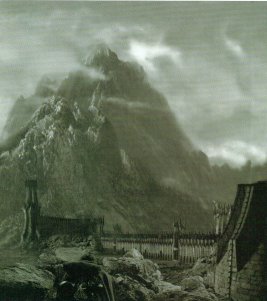 Main
entrance into Mordor. The Black Gate was located
at the northwestern corner of Mordor. It spanned Cirith
Gorgor, the Haunted Pass, at the point where the Ash
Mountains met the Mountains of
Shadow. Behind the Black Gate was the valley of Udun
which led to the plain of Gorgoroth.
Main
entrance into Mordor. The Black Gate was located
at the northwestern corner of Mordor. It spanned Cirith
Gorgor, the Haunted Pass, at the point where the Ash
Mountains met the Mountains of
Shadow. Behind the Black Gate was the valley of Udun
which led to the plain of Gorgoroth.
The Black Gate was made of iron set in a stone rampart that stretched between the high cliffs on either side of the pass. It had two great iron doors. There was a battlement across the top of the Black Gate which was patrolled by sentries. The Towers of the Teeth flanked the Black Gate: Narchost on the west, or right as one faced the Gate, and Carchost on the east or left. There were also hundreds of Orc-holes in the cliffs around the Black Gate.
In front of the Black Gate was the Desolation of the Morannon. It was an grim and barren land where nothing grew. There were mounds of blasted earth that leaked poisonous fumes. Two great Slag-hills faced the Black Gate. Mires and pools of mud and oily liquid stretched before the Black Gate like a moat. Beyond the Desolation of the Morannon was Dagorlad, the great Battle Plain.
Three roads converged at the Black Gate. One road came from the north across Dagorlad. Another came from the east alongside the Ash Mountains. This road was only about 50 miles long, extending just about to the point where Barad-dur stood on the other side of the Ash Mountains. The third road was the Harad Road which ran southward from the Black Gate through Ithilien and on to the southern lands of Harad.
The Black Gate was made by Sauron sometime after he chose Mordor as his realm in 1000 of the Second Age. In 3434, the War of the Last Alliance began with the Battle of Dagorlad on the plain in front of the Black Gate. The Men and Elves of the Last Alliance defeated Sauron's forces and assaulted the Black Gate. Sauron retreated to Barad-dur and the Army of the Last Alliance managed to enter the Black Gate behind him. The Siege of Barad-dur lasted seven years until 3441 when Sauron was finally defeated.
Saruon's spirit fled from Mordor into the East after the One Ring was taken from him. The Men of Gondor took control of the Black Gate and they built the Towers of the Teeth on either side of it. They kept watch over the Black Gate to guard against Sauron's return.
The watch on Mordor declined after the Great Plague in 1636 of the Third Age which killed many Men of Gondor. But the Black Gate remained under Gondor's control until at least 1944. In that year, King Ondoher of Gondor was slain in battle with the Wainriders in front of the Black Gate. The watch-towers of the Black Gate were abandoned by the Men of Gondor sometime afterwards - probably before 1980 when the Lord of the Nazgul returned to Mordor.
Sauron returned to Mordor in 2942 and the Black Gate was once more under his control. Armies of Easterlings and Haradrim came down the roads to the Black Gate to increase Sauron's forces.
On March 5, 3019, Frodo Baggins and Sam Gamgee were led to the Black Gate by Gollum. The Hobbits realized that the Black Gate was impassable and Gollum offered to lead them to the Pass of Cirith Ungol over the Mountains of Shadow about 100 miles to the south. On March 10, an army that came from the Black Gate captured Cair Andros and crossed the Anduin into Anorien north of Minas Tirith.
Sauron gathered his forces in Udun behind the Black Gate in preparation for a final assault against the forces of Gondor and Rohan. Inside Mordor, Frodo and Sam were caught up with a troop of Orcs heading to Udun but managed to escape.
Aragorn led the Host of the West to the Black Gate to give Frodo time to complete his quest to destroy the Ring. As they came to the Desolation of the Morannon, some of the Men were too afraid to continue and Aragorn sent them to retake Cair Andros.
On March 25, the Host of the West came before the Black Gate and Aragorn positioned his troops on the Slag-hills. The Mouth of Sauron emerged from the Black Gate to offer terms of surrender but Gandalf rejected them. Then the two doors of the Black Gate opened wide and a great army came forth from Udun and from the cliffs on either side. Sauron's forces fought the Host of the West in the Battle of the Morannon.
When the Ring was destroyed in Mount Doom, Sauron was defeated and his armies fled or surrendered. Mordor fell into ruin and the Black Gate was cast down and broken.
Note:
Some early editions of The
Lord of the Rings describe the Black Gate as having three doors
but this has been corrected in more recent editions.
Names &
Etymology:
The Sindarin name for the Black
Gate was the Morannon from mor meaning "dark, black"
and annon meaning "great door or gate." Also called the Gates
of Mordor.
Sources:
The Fellowship
of the Ring: "The Council of Elrond," p. 256, 266; "Farewell to Lorien,"
p. 390
The Two
Towers: "The Passage of the Marshes," p. 235, 238-40; "The Black Gate
Is Closed," passim; "Of Herbs and Stewed Rabbit," p. 256-57; "The Forbidden
Pool," p. 300-301; "Journey to the Cross-roads," p. 303, 311
The Return
of the King: "The Siege of Gondor," p. 90, 93; "The Black Gate Opens,"
p. 162-69; "The Tower of Cirith Ungol," p. 176; "The Land of Shadow," p.
205, 208-209; "Mount Doom," p. 210; "The Field of Cormallen," p. 227; "The
Steward and the King," p. 240-41
Appendix
A of The Lord of the Rings: "Gondor and the Heirs of Anarion," p. 329
Appendix
B of The Lord of the Rings: "The Tale of Years," p. 374-75
Unfinished
Tales: "The Disaster of the Gladden Fields," p. 280 note 14; "Cirion
and Eorl," p. 292-95, 312 note 15
The Silmarillion:
"Appendix - Elements in Quenya and Sindarin Names," entries for annon
and mor
The Lord
of the Rings: A Reader's Companion by Wayne G. Hammond and Christina
Scull: "The Black Gate Is Closed," p. 457; "The Black Gate Opens," p. 595;
"The Tower of Cirith Ungol," p. 602
The Dimrill Gate had two great doors that hung from tall doorposts. The doors bore messages in several languages inscribed in runes. In Khuzdul, the language of the Dwarves, there were spells of prohibition and exclusion. There were also warnings against entering without the permission of the King of Khazad-dum written in Quenya, Sindarin, the Common Speech, and the languages of Rohan, Dale, and Dunland.
Inside the Dimrill Gate was a guardroom and a pair of doors to the First Hall. The Dimrill Gate was on the First Level of Khazad-dum. The Levels above were numbered in relation to the First Level while the levels below were called Deeps. From the First Hall, a passageway and a staircase led down to the First Deep. At the foot of the stairs, the Bridge of Khazad-dum spanned a deep chasm to the Second Hall.
The halls nearest the Dimrill Gate were known as Old Moria. They were the oldest part of Khazad-dum, made by the Dwarves in the time of Durin I. Khazad-dum was gradually expanded until it stretched 40 miles from the Dimrill Gate in the east to the Doors of Durin in the west.
The realm of Khazad-dum endured for many millennia until 1981 of the Third Age, when the Dwarves fled after encountering the Balrog. Orcs and other evil creatures came to dwell there and it became known as Moria.
In 2790, Thror, the King of Durin's Folk, came to the Dimrill Gate in hopes of reclaiming Khazad-dum. The Gate was open and Thror entered but he was slain by the Orc-leader Azog and his body was thrown out onto the steps. The Dwarves declared war on the Orcs.
In 2799, the Battle of Azanulbizar was fought in the Dimrill Dale. The Dimrill Gate was damaged during the battle. Nain of the Iron Hills approached the Gate and called for Azog to come out, and they fought on the steps. Azog slew Nain, but Nain's son Dain Ironfoot killed Azog. Dain then looked through the Gate and realized that the Balrog still dwelled there, so the Dwarves did not reclaim Khazad-dum.
Gandalf entered Moria through the Dimrill Gate while searching for Thrain II who disappeared in 2845. Aragorn also passed through the Dimrill Gate during his journeys in Middle-earth.
In 2989, Balin led an expedition of Dwarves to reclaim Khazad-dum. The Dwarves drove the Orcs from the Dimrill Gate and established a colony. In 2994, Balin was killed and Orcs attacked the colony. The Dwarves barred the doors on the East-gate but they were overwhelmed and the colony was wiped out. The doors of the Dimrill Gate were shattered and cast down.
Gollum entered the Dimrill Gate in August of 3018 and made his way through Moria to the West-gate. The Fellowship entered Moria through the West-gate on January 13, 3019, and journeyed eastward followed by Gollum. On January 15, Gandalf confronted the Balrog on the Bridge of Khazad-dum and fell into the abyss. Aragorn led the others out of Moria through the Dimrill Gate.
Names &
Etymology:
Also called the East-gate
and the Great Gates.
Sources:
The Fellowship
of the Ring: "A Journey in the Dark," p. 310, 320, 323-24, 328-29,
332; "The Bridge of Khazad-dum," p. 335-37, 341-46; "Lothlorien," p. 347-53
Appendix
A of The Lord of the Rings: "Durin's Folk," p. 354-56
Appendix
B of The Lord of the Rings: "The Tale of Years," p. 369, 371-72
Unfinished
Tales: "The Quest of Erebor," p. 321, 327 note 5; "The Hunt for the
Ring," 345
The History
of Middle-earth, vol. XII, The Peoples of Middle-earth: "Of Dwarves
and Men," p. 319
Doors of Durin |
Top:
Doors of Durin in the New Line
film
Bottom: Doors of Durin by J.R.R. Tolkien |
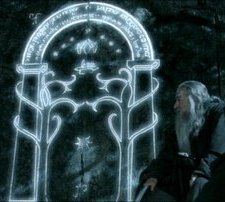 Doors
on the West-gate of Khazad-dum, or Moria. The
Doors of Durin were located in a cliff called the Walls of Moria on the
west side of the Misty Mountains. The
Doors opened onto a shallow valley at the base of the cliff.
Doors
on the West-gate of Khazad-dum, or Moria. The
Doors of Durin were located in a cliff called the Walls of Moria on the
west side of the Misty Mountains. The
Doors opened onto a shallow valley at the base of the cliff.
A road marked by two holly trees began at the Doors of Durin and ran westward to the Elven-realm of Eregion. Sirannon, the Gate-stream, flowed alongside the road. At the edge of the valley, the Sirannon cascaded over another cliff and formed the Stair Falls.
Inside the Doors of Durin was a flight of 200 stairs leading upwards. At the top was an arched passageway that twisted and turned and went downwards and was joined by many other hallways. The distance between the West-gate and the East-gate of Khazad-dum was about 40 miles.
The Doors of Durin were two tall stone slabs that opened outwards. From the inside they could be pushed open, although they were heavy and required two people or a strong person to do so. The Doors could not be forced inwards from the outside.
Like other Dwarf-doors, the Doors of Durin could not been seen when they were closed. Opening the Doors from the outside required a password which revealed the outline of the Doors and caused them to swing open. The password was mellon meaning "friend" in the Sindarin language of the Elves.
The Doors of Durin bore an elaborate design drawn in ithildin - a silvery substance derived from mithril. Ithildin could only be seen in starlight or moonlight and first had to be activated by touch and a special incantation.
At the top of the design was an arch
with an inscription in Sindarin using Tengwar characters. It gave the password
to open the Doors:
| Ennyn Durin Aran Moria: pedo mellon
a minno.
Im Narvi hain echant: Celebrimbor o Eregion teithant i thiw hin. |
The Doors of Durin, Lord of Moria.
Say "friend" and enter.
I, Narvi, made them. Celebrimbor of Eregion drew these signs. |
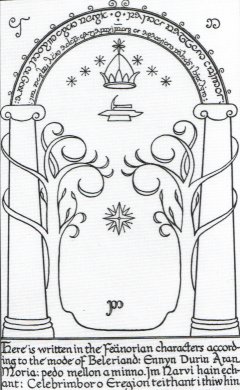 Two
pillars were drawn on either side of the Doors beneath the arch. Beside
the pillars stood two trees. Both trees represented Galathilion, the Tree
of the High Elves. Galathilion was made for the Elves by the Vala Yavanna
in the image of Telperion - one of the Two Trees of Valinor. Telperion
gave off a silver light and the Moon was made from one of its flowers.
In the engraving, the leaves of the trees were shaped like crescent moons.
Two
pillars were drawn on either side of the Doors beneath the arch. Beside
the pillars stood two trees. Both trees represented Galathilion, the Tree
of the High Elves. Galathilion was made for the Elves by the Vala Yavanna
in the image of Telperion - one of the Two Trees of Valinor. Telperion
gave off a silver light and the Moon was made from one of its flowers.
In the engraving, the leaves of the trees were shaped like crescent moons.
Near the top of the Doors under the arch was a hammer and anvil surmounted by a crown with seven stars. These were the emblems of Durin I. The stars each had eight rays and collectively represented the constellation called the Sickle of the Valar (known to us as the Plough or the Big Dipper).
At the center of the Doors was the eight-pointed Star of the House of Feanor. This emblem may have represented one of the Silmarils wrought by Feanor.
Near the bottom of the Doors was the Tengwar character ando which means "gate" and represents the letter d as in "Durin." In the upper left-hand corner of the Doors was the character calma representing c as in "Celebrimbor." The character óre in the upper right-hand corner usually represents r but in the Mode of Beleriand used on the Doors it stood for n as in "Narvi."
Narvi was the Dwarf-craftsman who made the Doors of Durin, and Celebrimbor was the Elven-smith who drew the design on the Doors. Celebrimbor lived in nearby Eregion which was founded by the Elves in 750 of the Second Age.
The Dwarves of Khazad-dum and the Elves of Eregion traded with each other, and the Doors of Durin were made to faciliate commerce between the two realms. During this peaceful period, the Doors usually stood open guarded by doorwards.
Eregion was destroyed during the War of the Elves and Sauron in 1697 of the Second Age. The King of Khazad-dum at this time was Durin III. He sent an army of Dwarves to help the Elves but in the end they were forced to retreat. The Doors of Durin were shut and Sauron's forces could not breach them.
In 1980 of the Third Age, the Balrog was awakened and the Dwarves abandoned Khazad-dum the next year in 1981. Evil creatures came to live there and it became known as Moria, the Black Chasm.
In 2989, Balin and a company of Dwarves entered Moria through the East-gate and tried to establish a colony, but within five years they were besieged. They tried to escape through the West-gate but discovered that the Gate-stream had been dammed and a wide pool had formed in front of the Doors of Durin. Oin was killed by a tentacled creature called the Watcher in the Water lurking in the pool.
In August of 3018, Gollum entered Moria through the East-gate and slowly made his way to the West-gate. He could not figure out how to open the Doors of Durin and he was too weak to push them outward regardless. He was lurking inside the West-gate when the Fellowship entered.
The Fellowship arrived at the Doors of Durin on January 13, 3019. Gandalf remembered the incantation to illuminate the design on the Doors but he did not know the password to open them. He initially translated the inscription as "Speak, friend, and enter." Merry Brandybuck questioned the meaning of this phrase but Gandalf thought the words were of no importance. Finally he realized that Merry was on the right track and that the password was contained in the phrase pedo mellon a minno which was correctly translated as "Say 'friend' and enter."
As the Fellowship started to enter the West-gate, they were attacked by the Watcher in the Water. Once they made it inside, the Watcher slammed the Doors of Durin shut behind them. The Watcher piled boulders in front of the Doors and uprooted the ancient holly trees that had stood before them.
It is possible that the Doors of Durin were unblocked after the War of the Ring. The realm of Khazad-dum was reestablished by Durin VII, probably during the Fourth Age.
Note on
the inscription:
There is a question as to why the
word Moria is used in the inscription on the Doors of Durin. At
the time the Doors were made, Khazad-dum was the name of the Dwarves'
realm, and the Sindarin equivalent was Hadhodrond. The name Moria
meaning "Black Chasm" became widely used after the Dwarves abandoned it
in the Third Age.
However, it is possible that the Elves used the name Moria at an earlier time to signify a dark underground place rather than a place of evil. Another possibility is that Gandalf translated the word Hadhodrond into the more common Moria when he read the inscription (as he read Hollin for Eregion) and that the illustration of the Doors in the Red Book was based on his translation instead of the actual inscription.
Names &
Etymology:
The Doors of Durin were named
after one of the Kings of Khazad-dum named Durin. This could have been
Durin III, though his reign was at the very end of the period of commerce
between Khazad-dum and Eregion and it seems likely that the Doors would
have been made earlier. Another possibility is Durin II who may have reigned
in the early part of the Second Age though his dates are unknown.
Also called the West-door, the West-gate, the Hollin Gate, and the Elven Doors.
Sources:
The Fellowship
of the Ring: "A Journey in the Dark," p. 313-24, 331; "The Bridge of
Khazad-dum," p. 336
The Lord
of the Rings: Index, entries for Star and Tree
Appendix
B of The Lord of the Rings: "The Tale of Years," p. 363-64, 372-73
Appendix
E of The Lord of the Rings: "Writing and Spelling," p. 396, 398 note
2, 400
Unfinished
Tales: "The History of Galadriel and Celeborn," p. 235, 238; "The Hunt
for the Ring," 345, 353 note 12
The Lord
of the Rings: A Reader's Companion by Wayne G. Hammond and Christina
Scull: "A Journey in the Dark," p. 279-283
Fen Hollen was guarded by a porter in a gate-house. The porter only unlocked the door when there was a funeral. At all other times, Fen Hollen was closed and locked. Only the Lord of the City and the people who tended the tombs could request entrance.
On March 15, 3019 of the Third Age, Denethor brough his wounded son Faramir to Fen Hollen and the porter opened the door at his command. Denethor intended to burn Faramir alive on a pyre in the House of the Stewards. Beregond tried to enter Fen Hollen to rescue Faramir, but the porter refused to unlock the door and drew his sword. Beregond killed the porter and went through the door to Faramir's aid, later followed by Gandalf and Pippin.
After Faramir had been saved, Beregond relocked Fen Hollen and took charge of the key at Gandalf's bidding.
Names &
Etymology:
Fen Hollen means "closed
door" from fen meaning "threshold, door" and hollen meaning
"closed." The proper, lenited form was Fen Chollen. It was also
called the Closed Door and the Steward's Door.
Sources:
The Return
of the King: "The Siege of Gondor," p. 99-101; "The Pyre of Denethor,"
p. 127, 131
The History
of Middle-earth, vol. V, The Lost Road and Other Writings: "The Etymologies,"
entry for PHEN
The Lord
of the Rings: A Reader's Companion by Wayne G. Hammond and Christina
Scull: "The Siege of Gondor," p. 550
On March 9, 3019 of the Third Age, Gandalf arrived at Forannest with Pippin Took. They were allowed to pass through the gate by Ingold. The Rammas Echor was breached by the forces of Sauron on March 13. Ingold and the guards from Forannest were the last to leave their post and retreat to Minas Tirith. Forannest was destroyed along with the rest of the wall.
The Rohirrim arrived at the ruins of Forannest on March 15. They passed through the breaches in the wall and engaged Sauron's forces in the Battle of the Pelennor Fields.
Names &
Etymology:
The name Forannest contains
the element for meaning "north" and what appears to be a form of
annon
which means "gate."
Sources:
The Return
of the King: "Minas Tirith," p. 20-22; "The Siege of Gondor," p. 95;
"The Ride of the Rohirrim," p. 111
The History
of Middle-earth, vol. VIII, The War of the Ring: "The Ride of the Rohirrim,"
p. 353-54; "The Story Foreseen from Forannest," p. 359
The Silmarillion:
"Appendix - Elements in Quenya and Sindarin Names," entries for annon
and formen
Great Gate/Seven Gates of Minas Tirith |
The
Great Gate in the New Line film
|
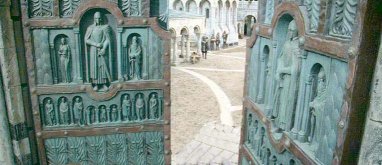 Gates
on the seven tiers of Minas Tirith. The
Great Gate was the main gate on the first level of the City. It was in
the City Wall - or Othram - facing eastward across the Pelennor
Fields toward the Anduin.
Gates
on the seven tiers of Minas Tirith. The
Great Gate was the main gate on the first level of the City. It was in
the City Wall - or Othram - facing eastward across the Pelennor
Fields toward the Anduin.
In front of the Great Gate there was a large paved area called the Gateway. The roads to Minas Tirith met here, including the North-way that joined the Great West Road to Rohan, the South Road to the southern provinces of Gondor, and the road to Osgiliath.
The Great Gate was made of iron and steel guarded by stone towers and bastions. The iron doors of the Gate rolled back to open. Passwords were required to enter the Great Gate and each of the six other gates of Minas Tirith.
Minas Tirith was built on a hill with seven concentric tiers culminating in the Citadel at the summit. Each tier was enclosed by a wall with its own gate. The gates were staggered to make the capture of the City by enemy forces more difficult. The Second Gate faced southeast, the Third Gate faced northeast, the Fourth Gate faced southeast, the Fifth Gate faced northeast, and the Sixth Gate faced southeast.
The Seventh Gate led to the Citadel. It faced eastward in line with the Great Gate, which was 700 feet below. The Seventh Gate could be reached through a sloping tunnel delved into the spur of rock that jutted out of the eastern face of the Hill of Guard. The keystone of the tunnel's archway was carved with the head of a crowned King. Guards of the Citadel manned the Seventh Gate.
The Great Gate was destroyed during the War of the Ring. Sauron's forces under the command of the Witch-king of Angmar besieged the City on March 13, 3019, of the Third Age. Before dawn on March 15, the battering ram Grond smashed the Great Gate three times while the Witch-king spoke words of power. "As if stricken by some blasting spell it burst asunder: there was a flash of searing lightning, and the doors tumbled in riven fragments to the ground." (RotK, p. 102) The Witch-king rode through the Gate where Gandalf awaited him, but then the Rohirrim arrived and the Witch-king went to fight them in the Battle of the Pelennor Fields where he was defeated.
A temporary barricade was erected in place of the Great Gate. After the war on May 1, Aragorn received the Crown of Gondor in front of the gate and then entered the City.
The Great Gate was rebuilt of mithril and steel by Gimli and Dwarves from the Lonely Mountain who had settled in the Glittering Caves.
Names &
Etymology:
The Great Gate was also called
the City-gate or
City Gate and the Gate of the City or
the Gate of Gondor. The other gates were referred to by number,
e.g., the Second Gate. The Seventh Gate was also called the
Citadel-gate.
Sources:
The Return
of the King: "Minas Tirith," p. 20, 22-25, 36, 41-44; "The Siege of
Gondor," p. 82-83, 93-103; "The Battle of the Pelennor Fields," p. 114,
118, 124; "The Pyre of Denethor," p. 126-27, 131-32; "The Houses of Healing,"
p. 134, 137; "The Last Debate," p. 157-58; "The Steward and the King,"
p. 244-46, 248, 250
Appendix
A of The Lord of the Rings: "Durin's Folk," p. 360
Chamber of Mazarbul |
The
Chamber of Mazarbul in the New
Line film
|
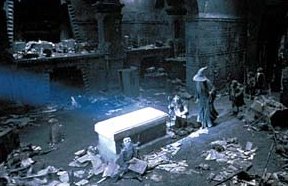 Chamber
of Records in Khazad-dum. The Chamber of Mazarbul
was located on the Seventh Level of Khazad-dum, six levels above the East-gate.
It was north of the Twenty-first Hall on the right-hand or east side of
the corridor. The main entrance from the corridor was a stone door on hinges.
Chamber
of Records in Khazad-dum. The Chamber of Mazarbul
was located on the Seventh Level of Khazad-dum, six levels above the East-gate.
It was north of the Twenty-first Hall on the right-hand or east side of
the corridor. The main entrance from the corridor was a stone door on hinges.
The Chamber of Mazarbul was a large square room. There was a window shaft high in the eastern wall and below it was a second door leading to a downward staircase. Records were kept in wooden iron-bound chests that were set in recesses in the walls.
When Balin came to reclaim Khazad-dum in 2989 of the Third Age, he set up his seat in the Chamber of Mazarbul and the Dwarves lived in the Twenty-first Hall nearby. The Dwarves kept a record of their expedition which was known as the Book of Mazarbul.
In 2994, Balin was killed by an Orc and a stone tomb was made for him in the Chamber of Mazarbul. The colony was soon overrun by Orcs and the Dwarves made a last stand in the Chamber of Mazarbul but they were all killed. Ori wrote the last entry in the Book of Mazarbul before he died.
The Fellowship came to the Chamber of Mazarbul on January 15, 3019, after spending the night in the Twenty-first Hall. They discovered Balin's Tomb and the Book of Mazarbul. Like the Dwarves they became cornered in the Chamber when Orcs and a Cave-troll approached the main door.
Frodo Baggins stabbed the foot of the Cave-troll when it tried to force open the door. The Orcs broke in with hammers and battering rams and the Fellowship fought them, killing thirteen until the rest fled. Frodo was speared by an Orc-chieftain but his life was saved by his coat of mithril mail. The Fellowship escaped through the east door of the Chamber of Mazarbul and down the stairs.
Gandalf remained and placed a shutting-spell on the door, but the Balrog came into the Chamber of Mazarbul and engaged in a battle of wills with Gandalf through the closed door. During the struggle, the door broke and the east wall and the roof of the Chamber of Mazarbul collapsed. The room and Balin's Tomb were buried in rubble.
Names &
Etymology:
Also called the Chamber of Records.
The word mazarbul means "records" in Khuzdul, the language of the
Dwarves.
Sources:
The Fellowship
of the Ring: "A Journey in the Dark," p. 333-34; "The Bridge of Khazad-dum,"
p. 335-42
The Hall of Fire was mainly a quiet place where people could sit and think. But at times, especially on high days, the Elves of Rivendell gathered in the Hall of Fire and shared stories and songs.
Frodo Baggins was reunited with Bilbo Baggins in the Hall of Fire on October 24, 3018 of the Third Age.
Sources:
The Fellowship
of the Ring: "Many Meetings," p. 242-50; "The Ring Goes South," p.
290
The Two
Towers: "The Choices of Master Samwise," p. 338
Tower HallHall of the Kings in the Minas Tirith. The Tower Hall was located in the base of the Tower of Ecthelion which stood in the Citadel on the seventh level of Minas Tirith. A long paved passage led from the eastern doors of the Tower to the polished metal door of the Tower Hall.The Tower Hall was lined on either side with tall pillars of black marble. The capitals of the pillars were carved with animals and leaves. Between the pillars were statues of the Kings of Gondor. There were deep windows on both sides of the Tower Hall in the aisles beyond the pillars. The vaulted ceiling was inlaid with gold. The floor was made of white polished stone inset with flowing patterns in many colors. The rulers of Gondor conducted affairs of state in the Tower Hall. At the far end of the Tower Hall was a dais with many steps leading up to the King's throne. Above the throne was a marble canopy shaped like the Crown of Gondor. A carved image of the White Tree set with gems was on the wall behind the throne. On the broad bottom step of the dais was a plain, black stone chair. The chair at the foot of the dais was used by the Stewards of Gondor who ruled in place of a King between 2050 and 3019 of the Third Age. After Aragorn was crowned King of Gondor on May 1, 3019, he sat upon the throne in the Tower Hall. Names &
Etymology:
Sources:
|
The
Tower Hall by Alan Lee
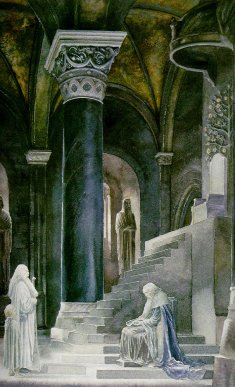 |
The Endless Stair was made in ancient times. The Dwarves eventually forgot where it was and some believed it existed only in legend.
The Balrog that dwelled beneath Khazad-dum knew the location of the Endless Stair and it led Gandalf there after they fell into the abyss from the Bridge of Khazad-dum. Gandalf and the Balrog climbed the Endless Stair and reached the top on January 23, 3019 of the Third Age. In the Battle of the Peak, Durin's Tower was destroyed and the top of the Endless Stair was blocked with rubble. Gandalf was rescued from the peak of the Silvertine by Gwaihir.
Sources:
The Two
Towers: "The White Rider," p. 105-6
Names &
Etymology:
The North Stair was apparently
so named because of its location on the northern border of Gondor.
Sources:
The Fellowship
of the Ring: "The Great River," p. 406; "The Breaking of the Fellowship,"
p. 418
The Lord
of the Rings: A Reader's Companion by Wayne G. Hammond and Christina
Scull: "The Great River," p. 346
Stairs of Cirith UngolThe Straight Star and the Winding Stair leading into Mordor. The Stairs of Cirith Ungol climbed eastward up the northern side of the Morgul Vale. Minas Morgul was on the opposite side of the valley.A path led to the Stairs from the Morgul-road. The path began to climb the sheer mountainside along a ledge with a chasm on the right as one ascended. After a short distance the mountainside curved outward and the path entered a narrow opening. Inside the passage was the Straight Stair with high cliff walls on either side. The Straight Stair was narrow and very steep. The steps were unevenly spaced and many were worn, cracked, or broken. At the top of the Straight Stair was a dark passage sloping upwards. The passage emerged onto a wide, level shelf with a wall on the left and an abyss on the right. The shelf was broken in places and was strewn with rubble. At the end of the long shelf was a sloping cliff. The Winding Stair curved back and forth across the face of the cliff. At one point, the Winding Stair overlooked a sheer drop down into the Morgul Vale. The Stairs then veered away from the valley up into the Mountains of Shadow. The Winding Stair was longer than the Straight Stair but was not as steep. At the end of the Stairs of Cirith Ungol was a short straight flight of steps. A long ravine stretched for about a mile onward to the foot of a cliff where the western entrance to Shelob's Lair was. The Great Spider Shelob lurked within the tunnels. On eastern side of the tunnel was the Pass of Cirith Ungol guarded by the Tower of Cirith Ungol. Gollum told Frodo Baggins and Sam Gamgee about the Stairs of Cirith Ungol after the Hobbits realized they could not enter Mordor through the Black Gate. They began to climb the Stairs on March 10, 3019 of the Third Age, and reached the top on March 11. Gollum's intention was to bring the Hobbits to Shelob and seize the One Ring for himself after the Great Spider killed them. He went to visit Shelob while the Hobbits rested and returned on March 12 to find them asleep. Gollum nearly repented at that moment but when Sam awoke and accused him of sneaking, Gollum changed his mind and led them into Shelob's Lair. Sources:
|
Stairs
of Cirith Ungol
by Robert Goldsmith 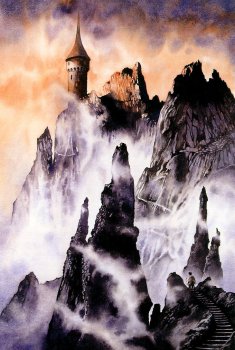 |
The Argonath |
The
Argonath in the New Line Film
|
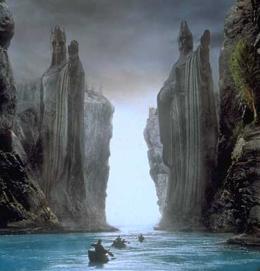 Great
statues on the Anduin. The two statues
of the Argonath stood on pedestals in the water on either side of the Great
River. Behind the statues, high cliffs formed a narrow chasm that the river
passed through before it widened to form the lake called Nen
Hithoel.
Great
statues on the Anduin. The two statues
of the Argonath stood on pedestals in the water on either side of the Great
River. Behind the statues, high cliffs formed a narrow chasm that the river
passed through before it widened to form the lake called Nen
Hithoel.
The Argonath were carved out of grey stone in the likenesses of Isildur and Anarion, the two sons of Elendil. The statues faced north with their left arms raised, palm outward. In their right hands they held axes and on their heads were helms and crowns. Their faces were grim and those who looked on them felt awe.
The Argonath were built to mark the northern boundary of Gondor by Romendacil II, probably around the year 1248 of the Third Age. No strangers were allowed to come south of the Argonath without permission. But as Gondor's power declined, this stricture was no longer enforced.
When Aragorn passed through the Gates of Argonath with the Fellowship on February 25, 3019, his bearing became more regal.
Frodo turned and saw Strider, and yet not Strider; for the weatherworn Ranger was no longer there. In the stern sat Aragorn son of Arathorn, proud and erect, guiding the boat with skilful strokes; his hood was cast back, and his dark hair was blowing in the wind, a light was in his eyes: a king returning from exile to his own land."Fear not!" he said. "Long have I desired to look upon the likenesses of Isildur and Anarion, my sires of old. Under their shadow Elessar, the Elfstone son of Arathorn of the House of Valandil Isildur's son heir of Elendil, has nought to dread!"
The Fellowship of the Ring: "The Great River," p. 409
Names
& Etymology:
Argonath means "stones of
the kings" from ar meaning "royal, king" and gonath meaning
"stones." Also called the Gate of Kings, Gates of Argonath, Gates
of Gondor, and
Pillars of the Kings.
Sources:
The Fellowship
of the Ring: "The Great River," p. 408-10
The Two
Towers: "The Departure of Boromir," p. 20
Appendix
A of The Lord of the Rings: "Gondor and the Heirs of Anarion," p. 326
The History
of Middle-earth, vol. XII, The Peoples of Middle-earth: "The Heirs
of Elendil," p. 198
When Durin I came to the Dimrill Dale in ancient times, he looked into Mirrormere and saw a crown of stars appear above his reflection in the water. Afterwards, a person looking into Mirrormere near Durin's Stone might be able to see the stars of Crown of Durin even in daylight.
On November 10, 2994 of the Third Age, Balin went to look into Mirrormere and was killed by an Orc arrow. When the Fellowship exited Moria on January 15, 3019, Gimli took Frodo Baggins and Sam Gamgee to stand beside Durin's Stone. The pillar was cracked and worn and the top was broken. They looked in the water and saw the stars but not their own reflections.
Source:
The Fellowship
of the Ring: "A Journey in the Dark," p. 329-30; "The Bridge of Khazad-dum,"
p. 336; "Lothlorien," p. 348
Púkel-men |
One
of the Pukel-men in the New Line
film
|
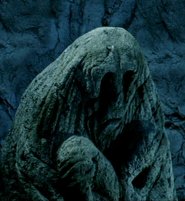 Ancient
statues on the road to Dunharrow
in Rohan. The Pukel-men stood at each turning
of the zig-zag path leading up to the stronghold in the valley of Harrowdale
in the White Mountains.
Ancient
statues on the road to Dunharrow
in Rohan. The Pukel-men stood at each turning
of the zig-zag path leading up to the stronghold in the valley of Harrowdale
in the White Mountains.
The Pukel-men were carved of stone in the image of short, squat Men sitting cross-legged with their arms folded across their round bellies. They resembled the Druedain, or Woses, who lived in the White Mountains in the First Age until they were driven out by the wicked Men of the Mountains.
The Druedain were known for carving stone images of themselves. They called these statues "watch-stones" and they placed them at turning points of paths. Orcs feared the watch-stones and were reluctant to pass them. It was believed that the Druedain transferred some of their own power into the watch-stones.
In one story called "The Faithful Stone," a Druadan left a watch-stone to guard his neighbor. When Orcs attacked the neighbor's house with fire, the stone image came to life and killed one of the Orcs. The legs of the watch-stone were burned, and the Druadan who made the stone also received burns on his legs though he was far away at the time of the attack.
Merry Brandybuck saw the Pukel-men when he came to Dunharrow with King Theoden on March 9, 3019 of the Third Age. Over the years, the statues had become weathered and aged, and most of their features had been worn away except for their deep eye sockets. The Pukel-men no longer evoked power or fear. The Rohirrim ignored them, and Merry felt pity for them.
Later, when Merry saw Ghan-buri-Ghan - the leader of the Druedain in the Druadan Forest - he was reminded of the Pukel-men.
Names &
Etymology:
Called watch-stones by the
Druedain. The name Púkel-men was given to the statues by
the Rohirrim. The element púkel comes from the Anglo-Saxon
púcel
meaning "goblin, demon."
Sources:
The Return
of the King: "The Muster of Rohan," p. 67-68; "The Ride of the Rohirrim,"
p. 106
Unfinished
Tales: "The Druedain," passim
The Hill of Erech was located in Gondor at the entrance to the Blackroot Vale in the White Mountains. The southern door of the Paths of the Dead was at the head of the Blackroot Vale.
The origins of the Stone of Erech are mysterious. Some believed that it had fallen from the sky, but the Stone was actually brought to the Hill of Erech by Isildur, who rescued it from the destruction of Numenor. How the Stone came to be in Numenor is not known. It may have been a natural rock formation, or it may have been shaped by hand, or it may even have been a meteorite.
In the early days of Gondor, the King of the Men who lived in the White Mountains swore an oath of allegiance to Isildur upon the Stone of Erech. But when Isildur called upon the Men of the Mountains to fight Sauron in the War of the Last Alliance, they broke their oath and refused. Isildur cursed them to remain undead until they fulfilled their oath, and they haunted the Paths of the Dead for over 3,000 years.
From time to time, the Dead would emerge from the mountains and gather around the Stone of Erech. The people who lived in the Blackroot Vale feared the Stone and dared not go near it.
On March 8, 3019 of the Third Age, Aragorn summoned the Dead to the Stone of Erech, and there at midnight he called upon them to fulfill their oath at last. The Dead accompanied Aragorn to Pelargir and helped capture the fleet of Sauron's allies the Corsairs. The Dead were then released by Aragorn and were finally able to rest in peace.
Names &
Etymology:
Also called the Black Stone.
Tolkien described the name
Erech as perhaps a "pre-Numenorean name
of long-forgotten meaning" that also fit with the Sindarin root er
meaning "one, single, alone."
(Letter #297) There
was also an ancient city in Mesopotamia called Erech, but Tolkien stated
that any connection was unintentional and subconscious at best.
Sources:
The Return
of the King: "The Passing of the Grey Company," p. 54-55, 61-63; "The
Last Debate," p. 150
The Letters
of J.R.R. Tolkien: Letter #297
Sources:
Map of "A
Part of the Shire," by Christopher Tolkien
The Return
of the King: "The Scouring of the Shire," p. 282; "The Grey Havens,"
p. 303
The Watchers |
The
Two Watchers of Cirith Ungol
in the New Line film |
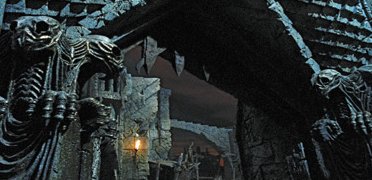 Sentinels
guarding the Tower of Cirith Ungol
and Minas Morgul. The Two Watchers
of Cirith Ungol were stone statues located on either side of the entrance
to the Tower courtyard. Each statue was composed of three joined bodies
with three heads resembling vultures looking out, in, and across the gateway.
Their eyes were set with black stones. The statues were seated on carved
thrones and had clawlike hands.
Sentinels
guarding the Tower of Cirith Ungol
and Minas Morgul. The Two Watchers
of Cirith Ungol were stone statues located on either side of the entrance
to the Tower courtyard. Each statue was composed of three joined bodies
with three heads resembling vultures looking out, in, and across the gateway.
Their eyes were set with black stones. The statues were seated on carved
thrones and had clawlike hands.
The Two Watchers were inanimate, but they were possessed by evil spirits and were aware of their surroundings. An invisible barrier stretched between the Two Watchers to prevent intruders from entering and prisoners from escaping. They had shrill voices to sound the alarm.
Minas Morgul was guarded by the Silent Watchers. The Silent Watchers are not identified, but they may have been statues like the Two Watchers - possibly the human and bestial figures that stood at the head of the bridge over the Morgulduin. The Silent Watchers were aware of everything that came near Minas Morgul.
The Silent Watchers became uneasy when Frodo Baggins and Sam Gamgee came to the Morgul Vale and ascended the Stairs of Cirith Ungol. Gorbag of Minas Morgul was sent to investigate, and on March 13, 3019, of the Third Age, he and Shagrat of the Tower of Cirith Ungol captured Frodo.
When Sam came to the Tower of Cirith Ungol to rescue Frodo on March 14, he was stopped by the invisible barrier of the Two Watchers. He brought out the Phial of Galadriel and the will of the Two Watchers was weakened so he was able to enter the gate. The Two Watchers sounded the alarm after he passed. On the way out in the early hours of March 15, Sam and Frodo again used the Phial and invoked the name of Elbereth in Elvish. The arch of the gateway collapsed and the Two Watchers gave another shirll cry but the Hobbits escaped.
Note:
In earlier drafts of the story,
the Hobbits' encounter with the Watchers took place at Minas Morgul instead
of Cirith Ungol. It is not clear whether Tolkien intended there to be Watchers
at both strongholds or whether the Silent Watchers of Minas Morgul were
a remnant of this earlier version.
Names &
Etymology:
The Watchers of Cirith Ungol were
called the Two Watchers and those of Minas Morgul were called the
Silent
Watchers.
Sources:
The Two
Towers: "The Black Gate Is Closed," p. 250; "The Stairs of Cirith Ungol,"
p. 313; "The Choices of Master Samwise," p. 348
The Return
of the King: "The Tower of Cirith Ungol," p. 178-79, 191-92
The History
of Middle-earth, vol. VII, The Treason of Isengard: "The Story Foreseen
from Lorien," p. 340-43, 348 note 33
The History
of Middle-earth, vol. VIII, The War of the Ring: "The Black Gate Is
Closed," p. 123-26, 129 note 12
The barrows were arranged in rows for each line of Kings of Rohan. There were nine mounds on the west side for the First Line of Kings: Eorl the Young, Brego, Aldor, Frea, Freawine, Goldwine, Deor, Gram and Helm Hammerhand. On the east side there were eight mounds for the Second Line of Kings starting with Helm's nephew Frealaf followed by Brytta, Walda, Folca, Folcwine, Fengel, Thengel, and Theoden, who was buried on August 10, 3019 of the Third Age. A third row was begun after the death of Theoden's nephew Eomer in 63 of the Fourth Age, later followed by Eomer's son Elfwine.
The Kings were buried with their weapons and other possessions. Eorl's horse Felarofwas buried alongside him after they fell in battle in 2545. After the mound was raised over the King's tomb, the Riders of the King's House rode around the barrow singing a song honoring their liege. Afterwards a feast was held in Meduseld and the guests drank a toast to the King and his predecessors and to the new King.
Sources:
The Two
Towers: "The King of the Golden Hall," p. 111-12
The Return
of the King: "Many Partings," p. 254-55
Appendix
A of The Lord of the Rings: "The House of Eorl," p. 349-51
The 19 slain Hobbits were buried in a separate grave, marked by a garden and a stone memorial.
Source:
The Return
of the King: "The Scouring of the Shire," p. 295
The Battle of Unnumbered Tears was fought on Anfauglith at midsummer in 472 of the First Age. Afterwards, Orcs buried the bodies of the dead and their weapons in a mass grave.
Hurin was captured in the battle, and Morgoth brought him to the place where his brother Huor and the rest of his comrades were buried. The grave still smelled strongly of death. Morgoth forced Hurin to stand on the burial mound and look west toward Hithlum where his family and the remnants of his people lived. Hurin refused to tell Morgoth the location of the Hidden Realm of Gondolin, and Morgoth cursed his family and imprisoned Hurin on the pinnacle of Thangorodrim above Angband.
Huor's widow Rian gave birth to a son Tuor in late 472. She left her child in the care of Annael and the Elves of Mithrim and she went to find her husband's grave. She lay down on the hill and died there.
Names &
Etymology:
The name Haudh-en-Ndengin
means "Hill of the Slain" from
haudh meaning "mound" and ndengin
meaning "slain" from the root ndak meaning "slay."
The grave was also called Haudh-en-Nirnaeth meaning "Hill of Tears." The word nirnaeth means "lamentation" from nîr meaning "tear, weeping" and naeth meaning "biting" or "gnashing of teeth (in grief)." The Battle of Unnumbered Tears was called Nirnaeth Arnoediad.
Also called the Great Mound.
Sources:
The Silmarillion:
"Of the Fifth Battle," p. 197; "Of Turin Turambar," p. 198; "Appendix -
Elements in Quenya and Sindarin Names," entries for dagor and haudh
Unfinished
Tales: "Of Tuor and His Coming to Gondolin," p. 17; "Narn I Hin Hurin,"
p. 66, 68, 105-6, 146 note 3
The History
of Middle-earth, vol. V, The Lost Road and Other Writings: "The Etymologies,"
entries for NAK, NAY, NDAK, and NEI
Names &
Etymology:
Haudh in Gwanur means "Tomb
of the Twins" in Sindarin from haudh meaning "mound, grave, tomb"
and gwanur (or gwanun) meaning "twins" from gwa meaning
"together."
Sources:
Appendix
A of The Lord of the Rings: "The Stewards," p. 335; "The House of Eorl,"
p. 350
The History
of Middle-earth, vol. V, The Lost Road and Other Writings: "The Etymologies,"
entries for KHAG and WO
The History
of Middle-earth, vol. XI, The War of the Jewels: "Quendi and Eldar,"
p. 367-68
House of the Kings |
Arwen
at Aragorn's tomb in the New Line
film
|
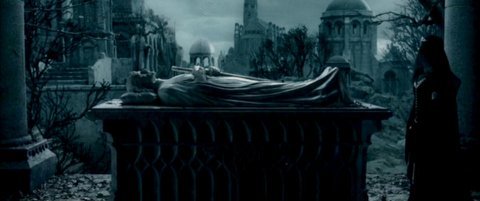 Burial
place of the Kings of Gondor. The House of the
Kings was located in Rath Dinen, the Silent
Street, in the Hallows on the fifth level of Minas
Tirith - which stood on the rocky spur joining the City to Mount
Mindolluin. The House of the Stewards
was nearby. The Kings of Gondor were laid to rest in tombs covered by marble
statues carved in their images.
Burial
place of the Kings of Gondor. The House of the
Kings was located in Rath Dinen, the Silent
Street, in the Hallows on the fifth level of Minas
Tirith - which stood on the rocky spur joining the City to Mount
Mindolluin. The House of the Stewards
was nearby. The Kings of Gondor were laid to rest in tombs covered by marble
statues carved in their images.
The last King of Gondor to be buried in the House of the Kings in the Third Age was Earnil II, who died in 2043 of the Third Age. Earnil's son Earnur went to Minas Morgul in 2050 and was never seen again. The Crown of Gondor remained on Earnil's tomb in the House of the Kings, and the Stewards ruled Gondor until the end of the Third Age.
During the reign of the Steward Cirion, the remains of Elendil - the first King of Gondor - were moved from the sacred burial site on the hill of Halifirien to the House of the Kings.
In the year 120 of the Fourth Age, Aragorn, King Elessar, went to the House of the Kings, where he passed the kingship to his son Eldarion and lay down to die. He was the first King of Gondor to be buried in the House of the Kings for over 1,000 years. It is said that the Hobbits Merry Brandybuck and Pippin Took - who had died some years previously - were moved to rest beside Aragorn in the House of the Kings.
Sources:
The Return
of the King: "The Siege of Gondor," 99-100
Appendix
A of The Lord of the Rings: "Gondor and the Heirs of Anarion," p. 332-33;
"The Tale of Aragorn and Arwen," p. 343-44
Appendix
B of The Lord of the Rings: "The Tale of Years," p. 378
Unfinished
Tales: "Cirion and Eorl," p. 310
House of the Stewards |
The
House of the Stewards in the New
Line film
|
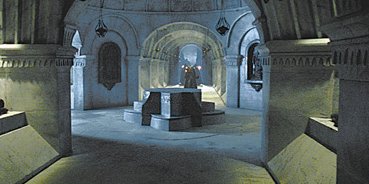 Burial
place of the Stewards of Gondor.
The House of the Stewards was located in the Hallows on the fifth level
of Minas Tirith on the rocky spur that joined
the City to Mount Mindolluin. The
House of the Stewards and the House of the Kings
stood in Rath Dinen – the Silent Street.
Burial
place of the Stewards of Gondor.
The House of the Stewards was located in the Hallows on the fifth level
of Minas Tirith on the rocky spur that joined
the City to Mount Mindolluin. The
House of the Stewards and the House of the Kings
stood in Rath Dinen – the Silent Street.
The House of the Stewards was a large building with a great dome. A flight of steps led to a porch before the front door. Inside was a wide vaulted chamber that housed the tombs of the Stewards. On each tomb lay a marble statue with folded hands and a pillow under the head.
On March 15, 3019 of the Third Age, as Minas Tirith was besieged by Sauron’s forces, the Steward Denethor brought his wounded son Faramir to the House of the Stewards. Denethor had looked into the palantir and had seen images that caused him to believe that the end was near for Gondor. Though Faramir was still alive, Denethor ordered a pyre to be lit to burn him and his son. Faramir was saved from the pyre by Gandalf, but Denethor perished in flames. The dome of the House of the Stewards cracked in the heat and collapsed into ruin.
Sources:
The Return
of the King: "The Siege of Gondor," p. 99-100; "The Pyre of Denethor,"
passim
The Ladybarrow was lost when Beleriand was destroyed in the War of Wrath at the end of the First Age.
Names &
Etymology:
The Ladybarrow was called
Haudh-en-Arwen
in Sindarin meaning "tomb of the lady." The word
haudh means "mound,
grave, tomb." Arwen means "royal maiden" from ar meaning
"royal" and wen meaning "maiden." It was called Tûr Haretha
in the language of the Haladin. The word tûr apparently means
"tomb" and haretha means "royal maiden" or "noble woman" where -eth
is a feminine ending.
Sources:
The Silmarillion:
"Of the Coming of Men into the West," p. 147; "Appendix - Elements in Quenya
and Sindarin Names," entries for ar and wen
The History
of Middle-earth, vol. V, The Lost Road and Other Writings: "The Etymologies,"
entry for KHAG
The History
of Middle-earth, vol. XI, The War of the Jewels: "The Later Quenta
Silmarillion," p. 223, 225, 228
Names &
Etymology:
The word howe is a Scottish
term for a hollow or depression.
Sources:
The Return
of the King: "The Battle of the Pelennor Fields," p. 120
The High Hay had been planted by the Hobbits of Buckland many generations before the War of the Ring as protection from the queer things in the forest to the east. The trees of the Old Forest had once attacked the Hedge, coming up close to it and leaning over it. The Hobbits had retaliated by cutting down hundreds of trees and making a bonfire and burning the ground in a long strip east of the Hedge. A bare patch known as the Bonfire Glade still remained many years afterwards.
There was a gate at the northern end of the High Hay where it met the Great East Road. This gate - called the North-gate, the Hay Gate, or the Buckland Gate - was guarded to prevent strangers from entering Buckland from the Road. Hob Hayward was one of the gate-guards. After the Nazgul attacked Frodo Baggins' house at Crickhollow on September 30, 3018 of the Third Age, they rode out of Buckland through the North-gate.
The Brandybucks also had a private gate near the middle of the High Hay. This was a locked iron gate in a brick-lined tunnel under the Hedge. On the morning of September 26, 3018, Merry Brandybuck led Frodo, Sam Gamgee, and Pippin Took through the gate and into the Old Forest.
Names &
Etymology:
Also called the Hay and the
Hedge. The word hay is an archaic term for "hedge" or "fence."
Sources:
The Fellowship
of the Ring: "A Conspiracy Unmasked," p. 109, 117-18; "The Old Forest,"
p. 120-21; "A Knife in the Dark," p. 189
The Return
of the King: "Homeward Bound," p. 276; "The Scouring of the Shire,"
p. 277
The Journeys
of Frodo by Barbara Strachey: Map #6, "The Brandywine Bridge to Bree"
& Map #7 "Bucklebury and the Hedge"
The northeastern part of the wall was farthest from the City, at a distance of 4 leagues (12 miles). There the wall was tall and strong and it stood on a bank overlooking a stretch of flat land that ran to the edge of the Anduin where the fords and bridges of Osgiliath were located. A walled Causeway led from the river to a guarded gate flanked by two guard-towers called the Causeway Forts.
In the northern part of the wall was the north-gate, called Forannest. Here the North-wayfrom Minas Tirith passed through the wall and joined the Great West Road. In the southern part of the wall between the Anduin and Mount Mindolluin, the South Road passed through another gate in the Rammas. The southeastern part of the wall was right on the riverbank, and there was a dock area called the Harlond below the wall. At that point the wall was only a league (3 miles) from the City.
It is not clear when the Rammas Echor was built. According to the text it was "after Ithilien fell under the shadow of their Enemy." (RotK, p. 22) This could be taken to mean when the Nazgul captured Minas Ithil in 2002 of the Third Age, or when Uruks attacked Ithilien in 2901, or when the last inhabitants of Ithilien fled in 2954.
But according to Tolkien's unfinished index the Rammas Echor was built during the reign of Denethor II, who became Steward in 2984. (Reader's Companion, p. 512) In order to reconcile this with the statement in the text, the wall may have been built as late as 3018 after Sauron's forces recaptured Osgiliath in June. In this case, the work being done on the wall on March 9, 3019, may have been the completion of the Rammas Echor rather than repairs to a damaged section.
Gandalf and Pippin came to the north-gate of the Rammas Echor on March 9. They were allowed to pass through by a guard named Ingold.
On March 12, a great force from Mordor led by the Lord of the Nazgul crossed the Anduin. Faramir rallied his men to the Causeway Forts, but they were outnumbered ten to one. Sauron's forces blasted holes in the Rammas Echor at many points and overran the Pelennor Fields on March 13. Minas Tirith was besieged.
But the destruction of the Rammas Echor worked against the Enemy in the end. At dawn on March 15, the Riders of Rohan came to the ruined wall where the north-gate had stood and passed through the breaches in the Rammas Echor onto the Pelennor Fields. The Rohirrim surprised the enemy forces, who had left the out-wall lightly guarded. The Battle of the Pelennor Fields raged until not one living enemy was left inside the Rammas. The battle within the encircling wall was remembered in song in Rohan:
Death in the morning and at day's ending
lords took and lowly. Long now they sleep
under grass in Gondor by the Great River.
Grey now as tears, gleaming silver,
red then it rolled, roaring water:
foam dyed with blood flamed at sunset;
as beacons mountains burned at evening;
red fell the dew in Rammas Echor.
The Return of the King: "The Battle of the Pelennor Fields," p. 125
Names
& Etymology:
Also called the Rammas and
the out-wall. Rammas Echor means "encircling wall." The word
rammas
is derived from ram meaning "wall." The word echor means
"encircling."
Sources:
The Return
of the King: "Minas Tirith," p. 20-22; "The Siege of Gondor," p. 89-97;
"The Ride of the Rohirrim," p. 108-111; "The Battle of the Pelennor Fields,"
p. 124-25
The Silmarillion:
"Appendix - Elements in Quenya and Sindarin Names," entries for echor
and ram
The History
of Middle-earth, vol. VIII, The War of the Ring: "Minas Tirith," p.
277-78; "The Siege of Gondor," p. 330-31; "The Ride of the Rohirrim," p.
353-54 (mention of Forannest)
The Lord
of the Rings: A Reader's Companion by Wayne G. Hammond and Christina
Scull: "Minas Tirith," p. 512
Flets |
The
Fellowship on a flet in the New
Line film
Art by Wayne Haag |
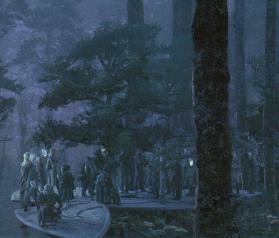 Tree
dwellings of the Elves. Flets were wooden platforms set among the branches
of trees. Some flets were simple, with no walls or rails and only a light
screen to block the wind. Houses were built on other flets, like the hall
of Galadriel and Celeborn
in Caras Galadhon, a city that
was a complex network of flets in the trees.
Tree
dwellings of the Elves. Flets were wooden platforms set among the branches
of trees. Some flets were simple, with no walls or rails and only a light
screen to block the wind. Houses were built on other flets, like the hall
of Galadriel and Celeborn
in Caras Galadhon, a city that
was a complex network of flets in the trees.
Flets came into use among the Elves of Lothlorien, where building materials were scarce and the threat from Moria and Dol Guldur made living in the relative safety of the trees desirable. Flets were originally used as refuges or outlook posts, but eventually they were used as dwellings as well. Because of this, the Elves of Lothlorien came to be called the Galadhrim, or Tree-people.
It is not certain who originated the idea of living on flets. It may have been King Amroth of Lorien, who built a house in the trees of Cerin Amroth, but he may have gotten the idea from his lover Nimrodel, who was said to have lived in the trees near the stream that was named after her.
Amroth's flet was once the highest in Lothlorien and was used to keep watch on Dol Guldur across the Anduin. Later, the highest flet was in Caras Galadhon.
When the Fellowship came to Lothlorien in January 3019 of the Third Age, they spent their first night in a flet used by Haldir as a guard post on the northern borders of the forest. The next day they came to Cerin Amroth, and Frodo and Sam climbed to the white flet that had replaced King Amroth's house there. They were then brought to Caras Galadhon, the City of the Trees. There in an oval-shaped hall built on a wide flet around the trunk of a mallornthey met Galadriel and Celeborn.
Names &
Etymology:
Flet is an Old English word
meaning "floor." Also called talan (singular) and telain
(plural) in Quenya. The word talan also means "floor" in Quenya.
Sources:
The Fellowship
of the Ring: "Lothlorien," p. 355, 357-60, 364-66; "The Mirror of Galadriel,"
p. 368-69
Unfinished
Tales: "The History of Galadriel and Celeborn and of Amroth King of
Lorien," p. 245-46; Index, p. 439
The History
of Middle-earth, vol. V, The Lost Road and Other Writings: "The Etymologies,"
TAL
entry
Seat of Seeing |
The
Seat of Seeing in the New Line
film
|
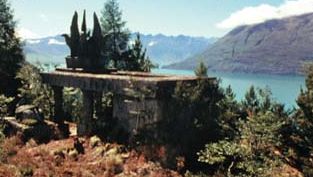 High
seat on Amon Hen. The Seat of Seeing
was on the summit of the hill in the center of a circle of flagstones surrounded
by a battlement. The Seat itself was a great chair set upon four carved
pillars. A stair with many steps led up to it. From the Seat of Seeing,
a person could see clearly for many miles around.
High
seat on Amon Hen. The Seat of Seeing
was on the summit of the hill in the center of a circle of flagstones surrounded
by a battlement. The Seat itself was a great chair set upon four carved
pillars. A stair with many steps led up to it. From the Seat of Seeing,
a person could see clearly for many miles around.
According to Aragorn, the seats on Amon Hen and Amon Lhaw were built in the days of the great Kings. It is not certain exactly when he meant, but it is likely that it was during the time of Isildur and Anarion since the Seat of Seeing is referred to as a work of the Men of Numenor. In choosing the Fellowship's course down the Anduin, Aragorn hoped to have a chance to look out from the Seat of Seeing.
On February 26, 3019 of the Third Age, Frodo Baggins climbed to the top of Amon Hen and sat in the high seat after Boromir tried to take the Ring from him. Frodo was wearing the Ring and at first as he looked around all seemed in shadow, but then the mist cleared and he could see far and wide. There was no sound, only vivid images. Frodo saw that war was brewing across Middle-earth, from Mirkwood and Lothlorien to Rohan and Gondor.
Then Frodo's gaze turned to Barad-dur in Mordor and he felt the Eye of Sauron seeking him. He threw himself down from the Seat of Seeing and tried to resist the temptation to reveal himself. A voice told him to take off the Ring and he felt torn between two powers. Unknown to Frodo, Gandalf was aware of his peril and was vying with the Dark Lord. Then suddenly Frodo felt himself free to choose and he took off the Ring and the Eye of Sauron could not find him. At that moment, Frodo decided that he must go alone to Mordor.
Aragorn came to the summit of Amon Hen seeking Frodo and he sat on the Seat of Seeing, but the world around seemed dim and remote and he saw nothing.
Names &
Etymology:
Also called the Seat of Amon
Hen.
Sources:
The Fellowship
of the Ring: "The Great River," p. 406, 410; "The Breaking of the Fellowship,"
p. 416-18, 421
The Two
Towers: "The Departure of Boromir," p. 15
All entries are Copyright © by the Thain from former tuckborough.net. Please contact me if you are Thain or know anything about how to contact the original author.
2003-2011, The Thain's Book - thainsbook.minastirith.cz
- e-mail: thain at tuckborough.net